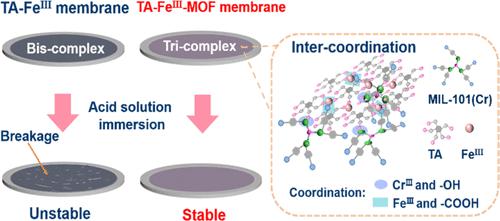当前位置:
X-MOL 学术
›
Environ. Sci. Technol.
›
论文详情
Our official English website, www.x-mol.net, welcomes your feedback! (Note: you will need to create a separate account there.)
Enhancing Stability of Tannic Acid-FeIII Nanofiltration Membrane for Water Treatment: Intercoordination by Metal–Organic Framework
Environmental Science & Technology ( IF 11.4 ) Pub Date : 2022-11-18 , DOI: 10.1021/acs.est.2c05048 Huimin Zhou 1 , Ruobin Dai 1 , Tianlin Wang 1 , Zhiwei Wang 1
Environmental Science & Technology ( IF 11.4 ) Pub Date : 2022-11-18 , DOI: 10.1021/acs.est.2c05048 Huimin Zhou 1 , Ruobin Dai 1 , Tianlin Wang 1 , Zhiwei Wang 1
Affiliation

|
Tannic acid (TA)-FeIII nanofiltration (NF) membrane has been demonstrated to possess more favorable removal of trace organic contaminants (TrOCs) over the conventional polyamide NF membrane. However, the drawback of acid instability severely hinders the practical application of TA-FeIII NF membrane in the treatment of (weak) acidic wastewater containing TrOCs (e.g., pharmaceutical wastewater, surface water, and drinking water). Herein, we introduced the MIL-101(Cr) nanoparticle, a kind of metal–organic framework (MOF), into the TA-FeIII selective layer to enhance the membrane acid stability. The acid-tolerance parameter of MIL-101(Cr)-stabilized TA-FeIII membrane (TA-FeIII-MOF membrane, 12,000 ppm/s–1) was two orders of magnitude larger than that of the TA-FeIII membrane (50 ppm/s–1), and the TA-FeIII-MOF membrane can withstand acid treatment at pH = 4 for more than 30 days. Meanwhile, the TA-FeIII-MOF membrane displayed increased water permeance from 9.5 to 12.7 L/(m2·h·bar) after the MOF addition, without compromising the selectivity. The enhanced acid stability for the TA-FeIII-MOF membrane was ascribed to an intercoordination mechanism, where FeIII centers (from TA-FeIII complex) coordinated with −COOH groups (from terephthalic acid of MOF) and CrIII centers (from MOF) coordinated with −OH groups (from TA of TA-FeIII complex), which was verified by the density functional theory calculation. This study highlights a new approach for the development of a TA-FeIII-based NF membrane with markedly enhanced acid stability, which is important for its real application in wastewater treatment and water reuse.
中文翻译:

提高水处理中单宁酸-FeIII 纳滤膜的稳定性:金属-有机骨架的相互作用
单宁酸 (TA)-Fe III纳滤 (NF) 膜已被证明比传统的聚酰胺 NF 膜更有效地去除痕量有机污染物 (TrOCs)。然而,酸不稳定性的缺点严重阻碍了TA-Fe III NF膜在处理含TrOCs的(弱)酸性废水(如制药废水、地表水和饮用水)中的实际应用。在此,我们将 MIL-101(Cr) 纳米颗粒(一种金属有机骨架 (MOF))引入到 TA-Fe III选择性层中,以增强膜的酸稳定性。MIL-101(Cr)-稳定的 TA-Fe III膜的耐酸参数(TA-Fe III -MOF 膜,12,000 ppm/s–1 ) 比TA-Fe III膜(50 ppm/s –1)大两个数量级,TA-Fe III -MOF 膜可以在pH = 4 的情况下承受酸处理超过30 天。同时,添加 MOF 后,TA-Fe III -MOF 膜的水渗透率从 9.5 升至 12.7 L/(m 2 ·h·bar),且选择性没有受到影响。TA-Fe III -MOF 膜增强的酸稳定性归因于相互配位机制,其中 Fe III中心(来自 TA-Fe III络合物)与 -COOH 基团(来自 MOF 的对苯二甲酸)和 Cr III配位中心(来自 MOF)与 -OH 基团(来自 TA-Fe III络合物的 TA)配位,这已通过密度泛函理论计算得到验证。这项研究强调了一种开发具有显着增强的酸稳定性的 TA-Fe III基纳滤膜的新方法,这对于其在废水处理和水回用中的实际应用非常重要。
更新日期:2022-11-18
中文翻译:

提高水处理中单宁酸-FeIII 纳滤膜的稳定性:金属-有机骨架的相互作用
单宁酸 (TA)-Fe III纳滤 (NF) 膜已被证明比传统的聚酰胺 NF 膜更有效地去除痕量有机污染物 (TrOCs)。然而,酸不稳定性的缺点严重阻碍了TA-Fe III NF膜在处理含TrOCs的(弱)酸性废水(如制药废水、地表水和饮用水)中的实际应用。在此,我们将 MIL-101(Cr) 纳米颗粒(一种金属有机骨架 (MOF))引入到 TA-Fe III选择性层中,以增强膜的酸稳定性。MIL-101(Cr)-稳定的 TA-Fe III膜的耐酸参数(TA-Fe III -MOF 膜,12,000 ppm/s–1 ) 比TA-Fe III膜(50 ppm/s –1)大两个数量级,TA-Fe III -MOF 膜可以在pH = 4 的情况下承受酸处理超过30 天。同时,添加 MOF 后,TA-Fe III -MOF 膜的水渗透率从 9.5 升至 12.7 L/(m 2 ·h·bar),且选择性没有受到影响。TA-Fe III -MOF 膜增强的酸稳定性归因于相互配位机制,其中 Fe III中心(来自 TA-Fe III络合物)与 -COOH 基团(来自 MOF 的对苯二甲酸)和 Cr III配位中心(来自 MOF)与 -OH 基团(来自 TA-Fe III络合物的 TA)配位,这已通过密度泛函理论计算得到验证。这项研究强调了一种开发具有显着增强的酸稳定性的 TA-Fe III基纳滤膜的新方法,这对于其在废水处理和水回用中的实际应用非常重要。



























 京公网安备 11010802027423号
京公网安备 11010802027423号